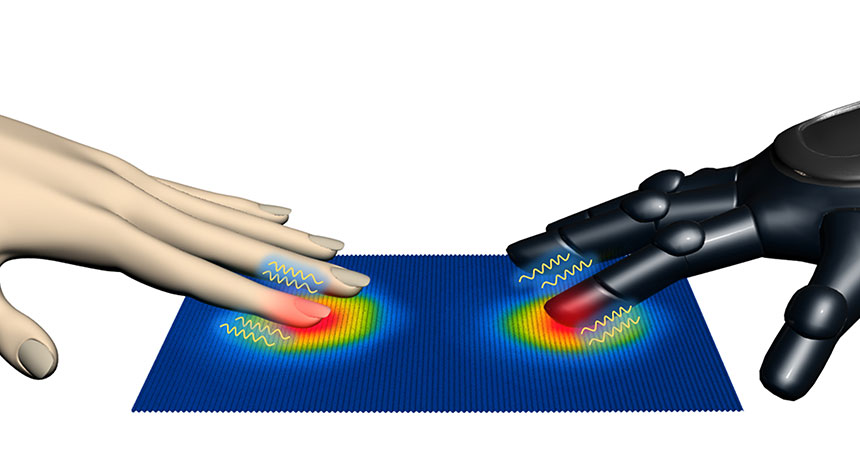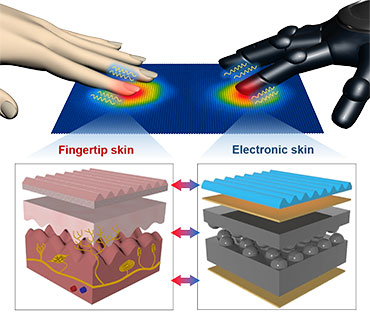New e-skin feels heat, textures and more
This new simulated skin could make prosthetic limbs and other medical devices work more like the real thing

Engineers have created an electronic skin that can sense pressure, textures, temperatures — even sound.
Park et al/Ulsan National Institute of Science and Technology
By Meghan Rosen
A new electronic skin can feel the raspy texture of sandpaper, the beat of someone’s pulse and even heat. But there’s more. It also can detect sound.
This rubbery plastic-and-carbon film mimics the structure of human skin, reports Hyunhyub Ko and his team in the October 30 Science Advances.
It’s the first time anyone has demonstrated an e-skin that can sense so many different types of stimuli, says Alex Chortos. “That’s the innovative and impressive part of this work,” points out this materials scientist. He works at Stanford University in Palo Alto, Calif.
Chortos is part of a team that developed another pressure-sensing e-skin. It can relay signals directly to brain cells, based on tests with cells that had been isolated from a mouse. Those cells got the skin’s message, too. They became more or less active depending on how hard researchers pushed on the skin. These researchers described their advance October 16 in Science.
Such work offers a blueprint for scientists to actually “bridge electronics with biology,” says Wenlong Cheng. He’s a chemical engineer at Australia’s Monash University in Clayton, Victoria.

One day, such an e-skin might cover prosthetic limbs and plug directly into people’s nerve cells, he says. This would let people know if they were touching something hot or rough or sharp — just as real skin does. The artificial skin also could form the basis for soft, wearable medical devices.
Over the last several years, scientists have invented an assortment of electronic-skin components. These range from different soft materials to new types of sensors. Some sensors can recognize more than one type of stimuli, Cheng says — but only under just the right conditions. E-skins are still “far from having the capabilities that human skin has,” he admits. But the newly reported advances do bring the prospect of such a technology closer.
By mimicking the ultrasensitive skin of human fingertips, Ko and his colleagues designed their e-skin to detect many types of signals. The researchers placed a soft ridged film over thin bumpy sheets made from plastic and graphene. (Graphene is a single-atom-thick sheet of carbon with a host of unusual properties.) Those thin bumpy sheets are only about as thick of a few layers of the plastic cling-wrap used to seal up kitchen leftovers.
Touching this e-skin pressed together the electrodes on the bumpy sheets. This caused an electric current to flow through the device, which was hooked up to a machine to measure such signals. The amount of current depended on how much the bumps compressed. This provided a gauge of the pressure.
Heating the Korean team’s e-skin also generated a current, showing that it could sense temperature, too. A strip of the e-skin placed on a person’s wrist let the researchers simultaneously measure skin temperature and blood pressure.
And ridges on this simulated skin help it detect texture. When researchers skimmed its surface over glass or sandpaper, the ridges vibrated. The pattern of those vibrations differed depending on what had touched it. Sensors in the skin picked up on those differences.
Sound waves also made the e-skin vibrate. It could “hear” noise from a speaker playing a famous lecture by the late physicist, Richard Feynman. The e-skin converted his words into electrical signals, and then sent them to a machine. This let the researchers judge how well the e-skin sensed sounds. It worked even better than an iPhone’s microphone, Ko concluded.
Cheng thinks such an e-skin might hold promise for use in soft, wearable hearing aids. Unlike conventional aids, he says, soft devices are more comfortable because they mold to human skin.
Power Words
(for more about Power Words, click here)
atom The basic unit of a chemical element. Atoms are made up of a dense nucleus that contains positively charged protons and neutrally charged neutrons. The nucleus is orbited by a cloud of negatively charged electrons.
chemical engineer A researcher who uses chemistry to solve problems related to the production of food, fuel, medicines and many other products.
electric current A flow of charge, called electricity, usually from the movement of negatively charged particles, called electrons.
Electrode (in chemistry) Materials that serve as an anode or cathode, attracting negatively or positively charged particles. Or things that serve as electric conductors through which current leaves or enters something else.
electronics Devices that are powered by electricity but whose properties are controlled by the semiconductors or other circuitry that channel or gate the movement of electric charges.
graphene A super-strong sheet of carbon that’s only one-atom thick. Because it also thin, transparent and can conduct electricity, the electronics industry is finding many potential uses for this material.
innovation (adj. innovative) An adaptation or improvement to an existing idea, process or product that is new, clever, more effective or more practical.
materials science The study of how the atomic and molecular structure of a material is related to its overall properties. Materials scientists can design new materials or analyze existing ones. Their analyses of a material’s overall properties (such as density, strength and melting point) can help engineers and other researchers select materials that best suited to a new application.
physicist A scientist who studies the nature and properties of matter and energy.
prosthesis (adj. prosthetic) An artificial device that replaces a missing body part. Such a prosthetic limb, for example, would replace parts of an arm or leg. These replacement parts usually substitute for tissues missing due to injury, disease or birth defects.
rasp (adj. raspy) A metal carpentry and metalworking tool that works like a coarse file to grind or scrape the rough edges off of something; or something that has an abrasive surface.
sensor A device that picks up information on physical or chemical conditions — such as temperature, barometric pressure, salinity, humidity, pH, light intensity or radiation — and stores or broadcasts that information. Scientists and engineers often rely on sensors to inform them of conditions that may change over time or that exist far from where a researcher can measure them directly. (in biology) The structure that an organism uses to sense attributes of its environment, such as heat, winds, chemicals, moisture, trauma or an attack by predators.
simulate To deceive in some way by imitating the form or function of something. A simulated dietary fat, for instance, may deceive the mouth that it has tasted a real fat because it has the same feel on the tongue — without having any calories. A simulated sense of touch may fool the brain into thinking a finger has touched something even though a hand may no longer exists and has been replaced by a synthetic limb. (in computing) To try and imitate the conditions, functions or appearance of something. Computer programs that do this are referred to as simulations .
stimulus (plural: stimuli) Something that prompts a response in a living organism or in a controlled environment (including a chemical or physical test system).







